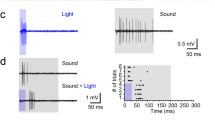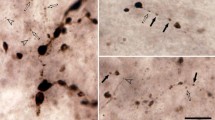Abstract
Evoked potentials (EP) and neuronal responses produced by tooth pulp stimulation and a clicking sound were recorded at different hippocampal sites using microelectrodes in unrestrained rats. Spatial distribution of EP was found to be the same for both types of stimulation. Averaged EP consisted of a high amplitude negative preceded by a low-amplitude positive component (N1 and P1, respectively). Latency of the N1 wave reached its minimum (of 27 msec) at the middle third of the molecular layer of the dentate gyrus and the outer portion of the CA3 apical dendrites. Latency of N1 was considerably longer in the stratum radiatum layer of the CA1. Laminar profiles of the amplitude of the N1 componenent of EP produced in the dentate gyrus and the CA3 by tooth pulp stimulation resemble those observed during perforant path stimulation; in the CA1 they are similar to those evoked by stimulating the Schaffer collaterals. Maximum amplitude of the P1 component was observed above the pyramidal layer of the CA1 and the hilus. Neuronal discharge pattern changed in all hippocampal regions under the effects of both tooth pulp stimulation and the clicking sound. It is deduced that information can reach the hippocampus by two routes: via a "fast" (inhibitory) pathway through the fimbria and the fornix and a slower (excitatory) path through the entorhinal cortex.
Similar content being viewed by others
Literature cited
V. M. Shaban, "Effects of severing afferent pathways on evoked potentials, theta rhythm, and neuronal activity in the hippocampus," Neirofiziologiya,1, No. 4, 437–444 (1970).
P. Andersen, T. V. P. Bliss, and K. K. Skrede, "Lamellar organization of hippocampal excitatory pathways," Exp. Brain Res.,41, No. 4, 315–324 (1971).
G. Buzsáki, E. Grastyán, I. N. Tveritskaya, and J. Czopf, "Hippocampal evoked potentials and EEG changes during classical conditioning in the rat," Electroencephalogr. Clin. Neurophysiol.,47, No. 1, 64–74 (1979).
G. Buzsáki, L. S. Leung, and C. H. Vanderwolf, "Cellular bases of hippocampal EEG in the behaving rat," Brain Res. Rev.,6, No. 2, 139–171 (1983).
G. Buzsáki, P. Rappelsberger, and L. Kellényi, "Depth profiles of hippocampal slow wave activity (theta rhythm) depend on behavior," Electroencaphalogr. Clin. Neurophysiol.,61, No. 1, 77–88 (1985).
S. A. Deadwyler, M. O. West, and J. H. Bobinson, "Entorhinal and septal inputs differentially control sensory evoked repsonses in the rat dentate gyrus," Science,211, No. 4487, 1181–1183 (1981).
J. Delacour, "Conditioned modifications of arousal and unit activity in the rat hippocampus," Exp. Brain Res.,38, No. 1, 95–101 (1980).
M. T. M. Jiffry, "Afferent innervation of the rat incisor pulp," Exp. Neurol.,73, No. 3, 209–218 (1981).
T. Lomo, "Patterns of activation in a monosynaptic cortical pathway: the perforant path input to the dentate area of the hippocampal formation," Exp. Brain Res.,12, No. 1, 18–45 (1971).
H. P. Rehnig, J. Brankack, and F. Klingberg, "Cortical tooth pulp evoked potentials in freely moving rat," Acta Neurobiol. Exp.,44, No. 5, 205–216 (1984).
G. Rose, "Physiological and behavioral characteristics of dentate granule cells," in: Neurobiology of the Hippocampus (W. Seifert, ed.), Academic Press, London (1983), pp. 449–472.
O. Steward, "Topographical organization of the projections from the entorhinal area to the hippocampal formation of the rat," J. Comp. Neurol.,167, No. 3, 285–314 (1976).
O. Steward and S. A. Scoville, "Cells of origin of entorhinal cortical afferents to the hippocampus and fascia dentata of the rat," J. Comp. Neurol.,169, No. 4, 347–370 (1976).
E. F. Vastola, "Electrical signs of an oligo-synaptic visual projection to rat hippocampus," Brain Behav. Evolut.,20, No. 1, 1–18 (1982).
O. S. Vinogradova, "Functional organization of the limbic system in the process of registration of information: facts and hypotheses," in: The Hippocampus, Vol. 2 (R. L. Isaacson and K. H. Pribram, ed.), Plenum Press, New York (1975), pp. 3–69.
B. A. Vogt and M. W. Miller, "Cortical connections between rat cingulate cortex and visual, motor and postsubicular cortices," J. Comp. Neurol.,216, No. 2, 192–210 (1983).
C. L. Wilson, T. L. Babb, E. Halgren, et al., "Habituation of human limbic neuronal responses to sensory stimulation," Exp. Neurol.,84, No. 1, 74–97 (1984).
Additional information
P. Flexig Institute for Brain Research, Karl Marx University, Leipzig, DR. Institute of Physiology, Pecs University Medical School, Pecs, Hungary. Translated from Neirofiziologiya, Vol. 19, No. 1, pp. 36–46, January–February, 1987.
Rights and permissions
About this article
Cite this article
Brankack, J., Buzsáki, G. Spatial distribution of hippocampal response to tooth pulp stimulation and acoustic stimulation. Neurophysiology 19, 30–38 (1987). https://doi.org/10.1007/BF01055992
Received:
Issue Date:
DOI: https://doi.org/10.1007/BF01055992




